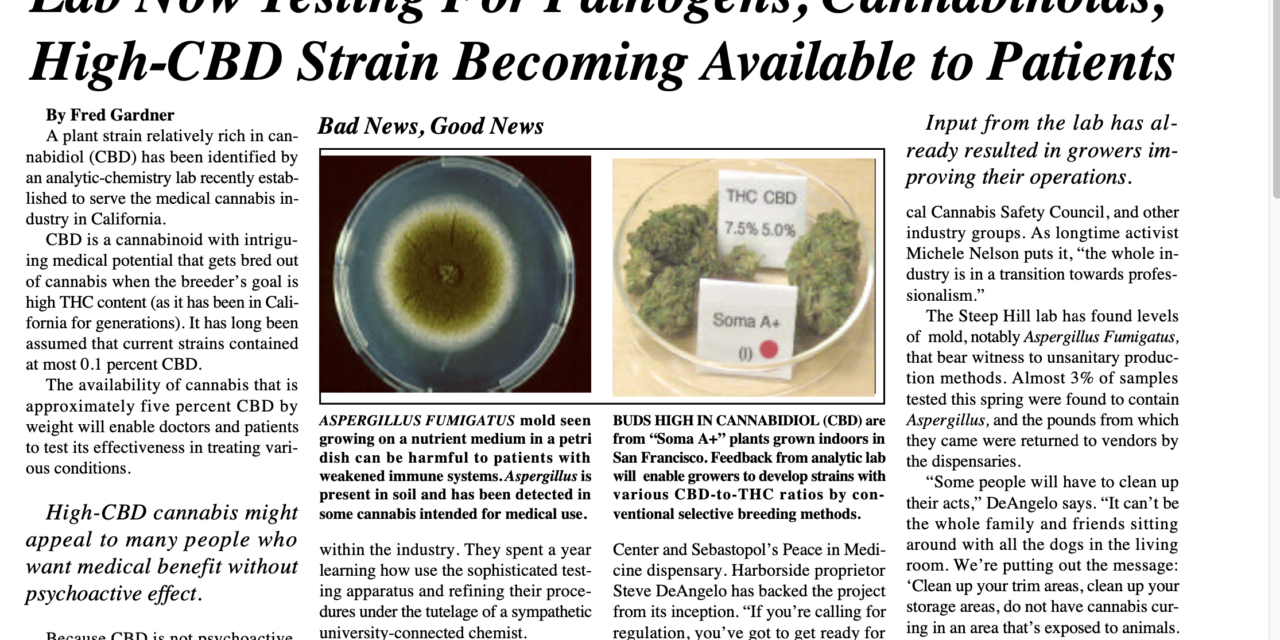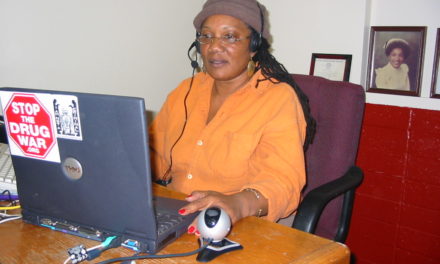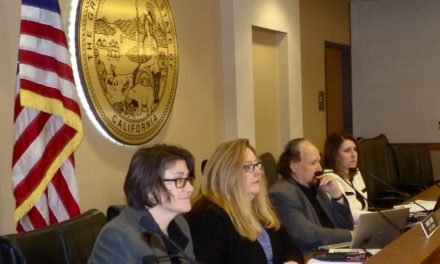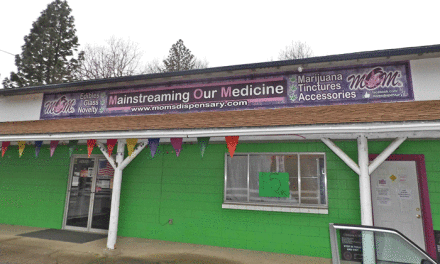By Fred Gardner December 6, 2022
To this day I’m kind of amazed when people flat-out lie to your face when they know you know the truth. Or they lie to the media when they’re aware that at least a few readers know the facts and will see them as a fraud. I shouldn’t be so naive, I’ve been around the block as they say –maybe two, three many blocks. And yet I was surprised to read the quotes from Andrew DeAngelo in a piece posted on SFGate Nov. 28 about the dubious integrity of the labs that analyze and certify the contents of cannabis products in California. According to the gullible reporter:
“The state’s first pot lab opened in 2009, at Oakland’s Harborside Health Center (now Harborside), a pioneering medical cannabis dispensary on the edge of the San Francisco Bay. At the time, there was no legal requirement to test cannabis, but Harborside’s owners wanted to make sure they weren’t selling pot laced with dangerous contaminants — particularly because many of their customers were fighting illnesses like cancer, according to Harborside co-founder Andrew DeAngelo.
“We were worried about mold; we were worried about things that could get in people’s lungs that could hurt them,” DeAngelo told SFGate. “The lungs are very fragile, and if you get mold in there, and you have a compromised immune system, it’s one of the only ways cannabis can kill you.”
I called a knowledgable friend for a reality check. He explained, as if to a child, “People lie brazenly like that when they know there won’t be any consequences. Nobody who Andrew considers important will know that he was bullshitting.”
The first analytic chemistry lab to test cannabis buds for mold and potency, Steep Hill, began doing business in December 2008. The founders were David Lampach, a nervous New Yorker who had worked on Wall St then moved to California to grow marijuana, and Addison DeMoura, a glad-handing bro who had moved from Massachusetts to Modesto to open a dispensary. Harborside was their essential first client. Steve DeAngelo (who had moved here from Washington, DC, in 2005) encouraged them and put up some money, but the main investor was Lampach’s brother (or father; my sources disagree). The name “Steep Hill” was Lampach’s double-entendre reference to his grow on a mountain east of Willits and the arduous job he was undertaking. A scientist from Livermore Labs taught him how to operate a gas chromatograph
A source who worked at Steep Hill in the early years, says “I only saw Steve DeAngelo come by the lab once. He looked around and said, ‘When are you guys going to redecorate?'” The specter of mold that brother Andrew invoked to the SFGate reporter had been greatly exaggerated by Steve, a brilliant promoter. Although it was possible that exposure to aspergillus fumigatus could kill a very sick AIDS patient, I had never heard of it happening.
Harborside’s real goal in ascertaining the contents of the herb they were buying and selling was financial. The lab was paid to analyze buds for THC, CBN and CBD content. Buds high in THC could be marked up by and sold as “top shelf.” CBN is a degradation product of THC, so if a grower brought in excellent herb that was say, 0.9% CBN, Harborside’s purchasing agents were instructed to tell them “This is obviously last year’s crop, or you didn’t cure it properly,” and knock down the price. The lab tested for CBD because Dr. Tod Mikuriya and O’Shaughnessy’s journal had gotten the word out that “THC’s non-psychoactive cousin” had medicinal benefits.
To the charge that I promoted the launch of Steep Hill lab I plead guilty with an explanation. I saw it as an essential step in developing a domestic supply of CBD-rich marijuana. I had a son with epilepsy who had not been helped by any of the six pharmaceutical anti-convulsants he’d been put on. Nor did the implant inflicted on him by UCSF neurosurgeons. (I had begged him not to risk it, but my influence was less than zero.)
One afternoon in the summer of ’98, when John was 33, I interviewed Dr. Geoffrey Guy outside the conference center where the International Cannabinoid Research Society (ICRS) was meeting. Guy’s company, GW Pharmaceuticals, had gotten approval from the British Home Office to grow cannabis rich in cannabidiol (CBD), an anti-convulsant. At this time the conventional wisdom held that THC was “the active ingredient in marijuana.” With the exception of the ICRS scientists and Dr. Mikuriya (who had compiled an anthology of the pre-prohibition medical literature) nobody, not even the most ardent activists, knew that other compounds in the plant exerted significant effects.
Guy and others I interviewed at the ICRS meeting in ’98 assumed that the marijuana being grown in California contained only trace amounts of CBD, because for decades growers had been breeding for maximum psychoactivity. Breeding for THC means breeding out CBD, Guy explained, because of a genetic either/or. Rosie, who was taking part in our conversation, laughed when I offered to bet Guy that some California marijuana would turn out to contain appreciable amounts of CBD. “The hills are full of hippies who save their seeds when a plant has an interesting effect,” I said hopefully. “If we had an analytic lab, we would find some.” Finding some CBD became my goal.
In 1998 I was editing Synapse, the internal weekly at UCSF Medical Center. I first wrote about CBD in the AIDS Treatment News, a newsletter produced by John James that was widely read in the Castro and beyond. In the summer of ’99 I attended the ICRS meeting again and wrote it up for Synapse, emphasizing the significance of CBD.
Dr. Mikuriya and I were about to launch our journal when the district attorney of San Francisco made me an offer I could have but didn’t refuse: to be his public information officer. It was an interesting gig that I’ve written about in the AVA and collected as “The Kayo Chronicles” at BeyondTHC.com.
In 2003 Dr. Mikuriya willed our journal into existence, naming it O’Shaughnessy’s to honor the doctor assigned to Calcutta by the East India Company who introduced cannabis to Western Medicine. (Epileptic seizures were among the conditions that William Brooke O’Shaughnessy had seen the Indian doctors treat effectively with a cannabis extract.) CBD was on our first front page, of course, in a piece introducing readers to the ICRS and the endocannabinoid system. Mikuriya paid for the printing of 15,000 papers by Howard Quinn, a union shop in San Francisco. Pro-cannabis doctors and dispensary owners bought them for $1/per and distributed them free to patients.
In every issue we pushed the gospel of CBD. In 2004 “Dr. X” (John McPartland) reported from the ICRS meeting: “The difference a decade makes! I presented a poster about CBD in 1994 and mine was the only mention of CBD at the conference. In 2004 we heard a dozen. The most noteworthy: Costa re CBD modulating neuropathic pain via vanilloid receptors, Fadda et al re CBD reversing impaired memory caused by THC, Ligresti et al re CBD’s anti-tumor activity, Liou et al. re: CBD preventing vascular permeability with therapeutic implications regarding diabetes; Cluny et al re CBDic acid attenuating emesis. The difference between 1994 and 2004? GW Pharmaceuticals sparking the interest and supplying the drug to researchers.”
Our Autumn 2005 editorial called for creation of a lab specifically to search for CBD: “The field of cannabis therapeutics will really take off once California growers have access to an analytical test lab and can determine the cannabinoid content of their plants. Then patients can begin treating their given conditions with strains of known composition —high in CBD to treat anxiety and insomnia, high in THC to stimulate appetite, etc. And SCC doctors and committed dispensary operators will be able to conduct clinical trials that transform anecdotal evidence into data acceptable to those members of the medical establishment not totally in thrall to Big PhARMA.”
I am now through patting myself on the back and have some confessions to make. As a journalist I made no effort to confirm the real danger posed by aspergillus on cannabis and the real extent of the mold problem. I didn’t check the literature or seek a comment from Dr. Donald Abrams, who at worked on the AIDS ward at SF General Hospital. O’Shaughnessy’s willingly publicized Steve DeAngelo’s line. Tod and I saw the lab as a key step in our longterm “Project CBD.” Harborside bought 6,000 copies of the 2009 issue. Our press run was up to 25,000.
It was Steve Robinson, MD, president of the Society of Cannabis Clinicians, who forwarded the SFGate item quoted above. Dr. Robinson has been trying to get New York State to enforce some rigor on labs testing the contents of medical cannabis, and he was glad to see the problem getting publicized. Thinking about his efforts, I realized that two decades ago I might have been able to steer the movement/industry in a different direction –and I blew it.
As reported in the AVA, “For dispensary operators and many activists it was a great day in San Francisco when the Department of Public Health began issuing registration cards. There was a ceremony outside the old greystone DPH office at 101 Grove Street and speeches by the director, Mitch Katz, MD, and District Attorney Hallinan, and Police Chief Earl Saunders, and Supervisor Mark Leno and others. The first card was issued to Wayne Justmann, the widely respected organizer of the Patients Resource Center on Divisadero. He had been living with HIV for many years and still is, thanks to protease inhibitors. A crowd of pot partisans and Health Department workers cheered heartily.
Hallinan had assigned me to help implement Prop 215 in San Francisco, and I wrote a righteous speech for him to give that day. He said, “”Last month the health department co-sponsored a conference at which the leading researchers updated doctors and other health professionals on the work that’s being done. Far in the lead is an English company that is breeding plants strains with different components for use in clinical trials. This company has full government support.
“We have the San Francisco Department of Public Health and what the scientists call ‘the crude plant.’ We also have the protections offered by Prop 215 and a potential database unequalled anywhere. We can begin by tracking how many patients are using cannabis for what conditions, and what results they are getting. At some point we can provide an analytical chemist so that dispensaries, patients and growers can determine the cannabinoid content of their plants…”
Soon after the kick-off of the registration program I paid a visit to the DPH Assistant Director, Josh Bamberger, MD, to suggest that the department begin testing cannabis being sold at San Francisco dispensaries. He said that their budget was stretched thin, and couldn’t the DA’s office persuade the Police Department to use their lab for this important purpose? I thought but didn’t say, ‘Don’t be ridiculous.’
What I should have said was: “The lab will be a moneymaker –a steady source of revenue for the Department of Public Health.”
Steve DeAngelo, in my position, would have explained to Bamberger that dispensaries could and would pay for lab results. Steve DeAngelo was as radical as reality itself, he understood that to achieve his ambition –selling weed to the mass market– cannabis had to be made safe for capital. I had a different ambition and was as dreamy as Don Quixote.
Maybe it’s not too late to demand that the government take charge of the whole cannabis testing operation. The analytic chemists and their staffs should be civil servants, unionized and well paid. The state would be remunerated by the dispensary owners and by the cannabis tax money now going to law enforcement, the treatment racket, and miscellaneous boondoggles approved by the politicians.
While we’re reconfiguring the industry, California should stop wringing a 15% excise tax out of medical cannabis users. Prescription meds are not taxed by any state except Illinois, where the rate is 1%. Over-the-counter meds are taxed at the state sales tax rate, which in CA is 7.25%. Imposing a 15% excise tax on Cannabis is tantamount to saying “It’s not really medicine after all.” That’s what they were saying –DeAngelo and WeedMaps and Cannacraft and Sean Parker and George Soros’s operatives and all the ganjapreneurs and “investors” who imposed the Adult Use of Marijuana Act on us in 2016. Because there was so much more money to be made under the “legalization” rubric.





